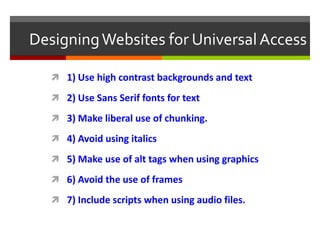Bo miller assignment 2.3
- 1. Assignment 2.3: Universal Design By: Bo Miller Universal design is the design of products and environments to be usable by all people, to the greatest extent possible, without the need for adaptation or specialized design. In addition, making a product or an environment accessible to people with disabilities often benefits others. For example, automatic doors are an example of Universal Design. The automatic door openers benefit individuals in wheelchairs and individuals using walkers, but also benefit people holding babies as well as elderly citizens.
- 2. The Process of Universal Design and Universal Design Principles The Process The Principles 1) Identify the application 2) Define the universe 3) Involve consumers 2) Flexibility in use 3) Simple and intuitive 4) Adopt guidelines or standards 5) Apply guidelines or standards 5) Tolerance for error 6) Plan for accommodations 6) Low physical effort 7) Train and Support 8) Evaluate 1) Equitable use 4) Perceptible information 7) Size and space for approach and use
- 3. The UDL Guidelines UD provides multiple means of UD provides multiple means of Engagement representation. 1) Provide options for perception. Provide options for language and symbols 2) 3) 2) Provide options for sustaining effort and persistence Provide options for comprehension UD provides multiple means of Action and Expression. 1) Provide options for physical action Provide options for expressive skills and fluency 2) 3) 3) Provide options for executive functions 1) Provide options for recruiting interest 3) Provide options for self-regulation
- 4. Implementing UDL In schools, there is a fixed curriculum designed for students but not all students. We have labeled the students for whom the curriculum does not work for as having a disability or being a slow learner. The UDL framework is being used help a wide range of students. Planning and Designing is important in UDL. UDL is good for everyone and is not designed for specific types of students.
- 5. Designing Websites for Universal Access 1) Use high contrast backgrounds and text 2) Use Sans Serif fonts for text 3) Make liberal use of chunking. 4) Avoid using italics 5) Make use of alt tags when using graphics 6) Avoid the use of frames 7) Include scripts when using audio files.




